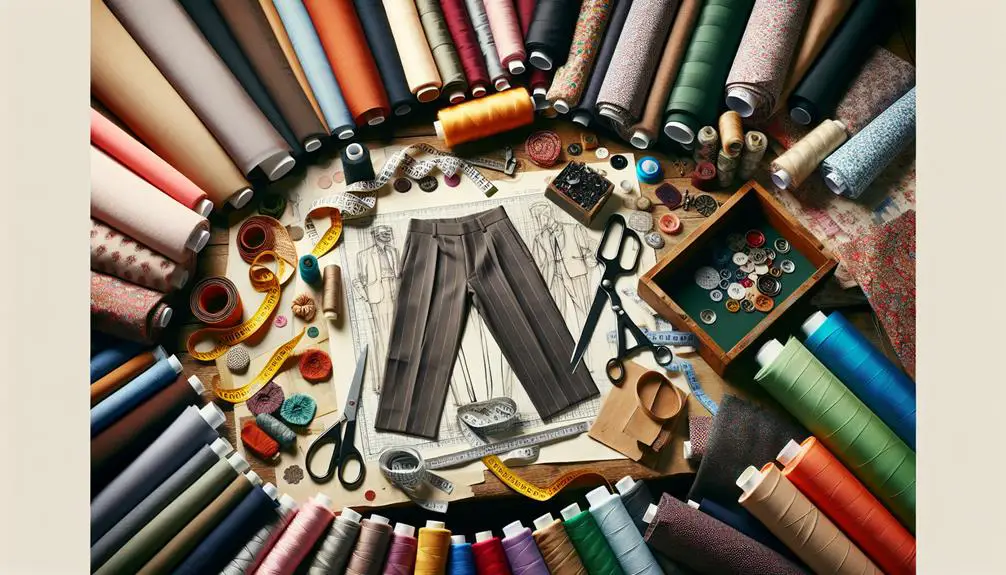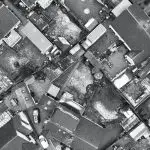When it comes to figuring out how many yards you need to make pants, it's not always a one-size-fits-all situation. The fabric requirements can vary based on numerous factors, like the style of pants you want to sew, your size, and the type of fabric you plan to use.
While the average yardage for adult pants is around 2.5 yards, there are crucial considerations that can influence this estimate. Understanding these nuances is key to ensuring your project turns out just right.
Table of Contents
Key Takeaways
- Pant style and size dictate fabric yardage needed.
- Consider fabric width, weight, and type for accurate calculations.
- Different pant styles require varying yardage amounts.
- Include extra fabric for adjustments and unforeseen errors.
Factors Affecting Fabric Yardage for Pants
When determining the fabric yardage needed for making pants, the size, style, and fabric type all play crucial roles in the calculation. The pants size directly impacts how much fabric you'll need. Larger sizes typically require more material compared to smaller sizes. For instance, crafting a pair of size 12 pants will demand more fabric than a size 6 due to the increased surface area.
Additionally, the fabric type is another key factor to consider. Different fabrics have varying weights and widths, affecting the amount needed for a particular size and style of pants. For example, lightweight cotton will require less yardage compared to heavier denim fabric because denim is denser and thicker.
Calculating Yardage for Different Pant Styles
So, when it comes to making different styles of pants, we need to consider how each style affects the amount of fabric required. Whether it's the fullness of palazzo pants or the tapered fit of skinny jeans, each style will demand a specific amount of yardage.
Additionally, adjusting for fit is crucial to ensure the pants are comfortable and look great on the wearer.
Pant Style Variations
Discussing various pant styles and their fabric requirements, it's essential to consider the fullness and design elements that influence the amount of fabric needed for each style.
When it comes to palazzo pants, you might need 4 to 4.5 yards of fabric, taking into account waist measurements and fabric width.
Harem pants can vary from 1 to 2.5 yards, depending on the fabric width and the desired style.
For wide-leg pants, typically 1 to 2 yards of fabric are necessary, factoring in considerations like lining and personal comfort preferences.
Each style offers a unique look and fit, requiring a specific amount of fabric to achieve the desired outcome.
Fabric Yardage Calculation
Calculating yardage for different pant styles depends on factors like fabric width, style variations, and size requirements. When determining how much fabric you need for making pants, consider these key points:
- Fabric Width Matters: The width of the fabric can significantly impact the amount of material required for your pants. Wider fabric may necessitate less yardage compared to narrower options.
- Types of Apparel Influence Yardage: Different types of pants, such as pleated versus non-pleated trousers, can affect the amount of fabric needed. Each style has unique fabric requirements.
- Consult Specific Patterns: Utilizing patterns designed for the particular pant style you're making can offer precise guidance on the exact yardage needed for your project.
Adjusting for Fit
When ensuring the right fit for pants, adjusting yardage becomes essential to account for individual measurements and style variations. When working on a sewing project, consider the person's waist size and hip width to accurately estimate the fabric needed.
Different pant styles, like those with pleats or gathers, may require varying amounts of fabric. It's crucial to calculate additional yardage for larger sizes to ensure a better fit.
Tailored pants demand precise measurements and adjustments to use the right amount of fabric. For accurate guidance on adjusting yardage based on desired fit and style, consulting sewing patterns is key.
Understanding Fabric Widths for Pant Making
I'll talk about fabric width options and how they influence the amount of yardage needed for making pants. Understanding these fabric widths is crucial for planning and cutting out your pant pieces efficiently.
Let's explore how the width of the fabric can impact your pant-making process.
Fabric Width Options
Wondering how fabric widths impact pant making? When considering fabric width options for making pants, it's essential to understand how they can influence your project. Here are some key points to keep in mind:
- Optimal Width Range: Fabrics for pants typically range from 58 to 60 inches wide, providing ample material for different sizes.
- Efficient Fabric Usage: Wider fabrics require less yardage for pant making due to their increased width, helping optimize fabric usage.
- Pattern Alignment Consideration: Some pant patterns may require more yardage to ensure proper pattern alignment and cutting precision.
Understanding these aspects of fabric widths will help you make informed decisions when selecting materials for your pant-making projects.
Calculating Yardage Needed
To accurately determine the yardage needed for making pants, consider the fabric width and the specific style and size of the pants. The fabric width plays a crucial role in how much fabric you'll need for your project. Typically, fabrics for pants range between 58 to 60 inches wide.
Wider fabrics generally require less material, affecting the total yardage needed. When calculating the yardage, make sure to account for any additional design elements such as pockets or cuffs, as they can influence the overall fabric requirements.
Understanding the relationship between fabric width and pants length is essential in ensuring you have the right amount of fabric to bring your pant-making project to life.
Yardage Requirements for Basic Pant Patterns
When planning to sew basic pant patterns, it's important to consider the yardage requirements for the fabric needed. Here's what you should know:
- Standard Yardage: Basic pant patterns for adult sizes typically require around 2.5 yards of apparel fabric. For children's pants, you might need a little less, ranging from 1.5 to 2 yards.
- Fabric Width Impact: Keep in mind that fabric width variations can impact the amount of material needed for your pants. Wider fabrics may require less yardage, while narrower ones might necessitate more.
- Custom Fits: If you're working with larger sizes or aiming for custom fits, you may need additional fabric yardage to accommodate alterations or adjustments. It's always best to double-check measurements and pattern requirements to ensure you have enough fabric and avoid running short during your sewing project.
Adjusting Yardage for Pant Size Variations
For different pant sizes, the amount of fabric required varies to accommodate the specific measurements and fit preferences. Larger sizes usually need more fabric, with sizes above average requiring around 3 yards or more. Plus-size pants may need extra yardage, ranging from 3 to 4 yards based on specific measurements.
On the other hand, smaller sizes like petite or slim-fit might only need 1.5 to 2 yards due to reduced leg width. When tailoring pants for kids or toddlers, you generally need 1 yard or less, considering their smaller stature and simpler designs.
It's essential to keep in mind that customizing pant lengths can impact fabric requirements; for instance, longer inseams or cuffs might increase the needed yardage. Understanding these variations in fabric needs based on different pant sizes ensures you have the right amount for a perfect fit without running short.
Tips for Efficient Fabric Cutting for Pants
Moving on to efficient fabric cutting for pants, one key tip is to use a rotary cutter or sharp fabric scissors for precise cutting. These tools help achieve clean edges and accurate shapes, essential for a well-fitting pair of pants.
Here are three additional tips to enhance your fabric cutting process:
- Marking Tools: Utilize chalk or fabric markers to outline cutting lines on the fabric. This step aids in maintaining straight lines and ensures your pieces match up correctly when sewing.
- Securing Materials: Use pattern weights or pins to secure both the pattern and fabric layers in place. This prevents shifting during cutting, resulting in more precise pieces that align correctly when assembling the pants.
- Space and Grainline: Cut your fabric on a flat, spacious surface to prevent distortions and ensure even edges. Additionally, always follow the grainline indicated on the pattern; this step is crucial for the proper drape and fit of the pants you're crafting.
Efficient cutting not only saves time but also minimizes errors, making the process of creating a pair of pants more enjoyable. Remember, when in doubt, it's always wise to buy a little extra fabric to account for any unexpected mishaps.
Making Shorts Vs. Long Pants: Fabric Differences
Shorts and long pants differ in the amount of fabric required due to their varying lengths and design features. When it comes to making shorts, you generally need a little more fabric compared to long pants because shorts are, well, shorter! The shorter length of shorts means that less fabric is needed to create them. However, the fabric quantity for shorts can still vary depending on the desired inseam length.
On the other hand, long pants typically require more fabric to accommodate the full leg length. Additionally, long pants may need extra fabric for cuffs or other design elements, which can further increase the overall fabric needed. When deciding how much fabric to use for shorts versus long pants, it's crucial to consider the intended use and style of the garment.
Pant Fabric Yardage for Different Materials
How do different materials impact the required yardage of fabric when making pants?
The type of fabric you choose can significantly influence how much material you need for your pants. Here are a few key points to consider:
- Fabric Weight: Lighter fabrics like cotton typically require less yardage compared to heavier materials such as denim or wool. The thickness and drape of the fabric play a role in determining the amount needed.
- Fabric Width: The standard width of fabric is around 45 inches. Wider fabrics can sometimes allow you to use less yardage, while narrower fabrics may require additional length to accommodate the pattern pieces.
- Specific Pant Styles: Different pant styles, such as wide-leg trousers versus slim-fit jeans, can impact the amount of fabric needed. Styles with more volume or extra details like pleats may require extra yardage to cut all the pieces correctly.
Estimating Yardage for Pant Lining and Interfacing
Estimating the required yardage for pant lining and interfacing is crucial for ensuring the comfort, durability, and overall quality of the garment. When it comes to lining, typically around 1 yard of fabric is needed, but this can vary based on the size and style of the pants. For interfacing, which is essential for supporting waistbands and pockets, you may need anywhere from 1/2 yard to 1 yard, depending on the weight of the interfacing. It's important to consider the fabric width when calculating the yardage for lining and interfacing to make sure you have enough to cover the necessary areas adequately.
To provide a clearer picture, let's look at the estimated yardage for pant lining and interfacing in the table below:
| Type | Lining Yardage | Interfacing Yardage |
|---|---|---|
| Lightweight | 1 yard | 1/2 yard |
| Heavyweight | 1.5 yards | 1 yard |
| Silk | 1.25 yards | 3/4 yard |
| Cotton | 1 yard | 1/2 yard |
Having the correct amount of lining and interfacing ensures that your pants maintain their shape, structure, and longevity, ultimately enhancing the quality of the garment.
Frequently Asked Questions
How Much Fabric Is Required for a Pant?
To make pants, you typically require around 2 yards of fabric for an average size. Smaller sizes may need 1 1/2 yards, while larger sizes might need more. Remember to account for fabric width variations.
How Many Yards Does It Take to Make a Pair of Jeans?
To make pants, you typically need around 2-3 yards of fabric for a pair of jeans. Factors such as size, style, and design details influence the exact amount. Following a sewing guide can give precise yardage recommendations.
Is 3 Yards Enough to Make a Dress?
Three yards might suffice for a simple dress, but designs with longer hems or sleeves could demand more fabric. It's wise to check the pattern for accuracy. Consider fabric width and design elements.
What Can 2 Yards of Fabric Make?
Two yards of fabric can yield a variety of projects. Depending on size and complexity, it could make a simple skirt, a top, a small bag, or even a set of throw pillows. The possibilities are endless!
- How Does Ring Spun Cotton Affect Garment Fit and Shape Retention? - August 13, 2024
- What Are the Challenges in Producing Ring Spun Cotton? - August 13, 2024
- Is Ring Spun Cotton Suitable for Plus-Size Clothing? - August 13, 2024







